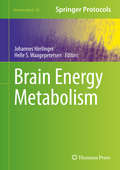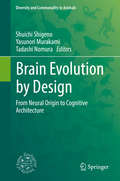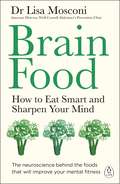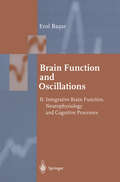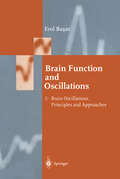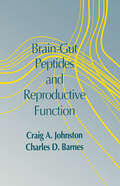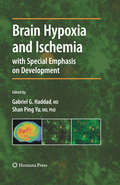- Table View
- List View
The Brain, Emotion, and Depression
by Edmund T. RollsThere are myriad questions that emerge when one considers emotions and decision-making: What produces emotions? Why do we have emotions? How do we have emotions? Why do emotional states feel like something? What is the relationship between emotion, reward value, and subjective feelings of pleasure? How is the value of 'good' represented in the brain? Will neuroeconomics replace classical microeconomics? How does the brain implement decision-making? Are gene-defined rewards and emotions in the interests of the genes? Does rational multistep planning enable us to go beyond selfish genes to plans in the interests of the individual? The Brain, Emotion, and Depression addresses these issues, providing a unified approach to emotion, reward value, economic value, decision-making, and their brain mechanisms. The evolutionary, adaptive value of the processes involved in emotion, the neural networks involved in emotion and decision making, and the issue of conscious emotional feelings are all considered. The book will be valuable for those in the fields of neuroscience, neurology, psychology, psychiatry, biology, animal behaviour, economics, and philosophy from the advanced undergraduate level upwards, and for all interested in emotion and decision-making.
Brain Energetics and Neuronal Activity: Applications to fMRI and Medicine
by Robert G. Shulman Douglas L. RothmanThis book is unique in linking in vivo 13C NMR measurements of neuronal activity and energetics with applications to functional imaging and certain disease states It provides a fundamental neurochemical explanation of brain activity applicable to functional imaging, theories of neuronal activity and disease states, e.g. epilepsy, psychiatric diseases and developmental disorders. Novel and potentially controversial Will inspire future research directions
Brain Energy Metabolism (Neuromethods #90)
by Johannes Hirrlinger and Helle S. WaagepetersenBrain Energy Metabolism addresses its challenging subject by presenting diverse technologies allowing for the investigation of brain energy metabolism on different levels of complexity. Model systems are discussed, starting from the reductionist approach like primary cell cultures which allow assessing of the properties and functions of a single brain cell type with many different types of analysis, however, at the expense of neglecting the interaction between cell types in the brain. On the other end, analysis in animals and humans in vivo is discussed, maintaining the full complexity of the tissue and the organism but making high demands on the methods of analysis. Written for the popular Neuromethods series, chapters include the kind of detailed description and key implementation advice that aims to support reproducible results in the lab.Meticulous and authoritative, Brain Energy Metabolism provides an ideal guide for researchers interested in brain energy metabolism with the hope of stimulating more research in this exciting and very important field.
Brain Evolution by Design: From Neural Origin to Cognitive Architecture (Diversity and Commonality in Animals)
by Shuichi Shigeno Yasunori Murakami Tadashi NomuraThis book presents a new, detailed examination that explains how elegant brains have been shaped in evolution. It consists of 19 chapters written by academic professionals in neuroscience, opening with the origin of single-celled creatures and then introducing primordial types in invertebrates with the great abundance of the brains of vertebrates. Important topics are provided in a timely manner, because novel techniques emerged rapidly—as seen, for examples, in the next-generation sequencers and omics approaches. With the explosion of big data, neural-related genes and molecules is now on the radar. In fact, Europe’s big science and technology projects, a €1 billion plan called the Human Brain Project and the Blue Brain Project to understand mammalian brain networks, have been launched in recent years. Furthermore, with the rise of recently advanced artificial intelligence, there is great enthusiasm for understanding the evolution of neural networks. The views from brain evolution in nature provide an essential opportunity to generate ideas for novel neuron- and brain-inspired computation. The ambition behind this book is that it will stimulate young scientists who seek a deeper understanding in order to find the basic principles shaping brains that provided higher cognitive functions in the course of evolution.
Brain Failure (Update in Intensive Care and Emergency Medicine #9)
by John W. Holaday DavidBihariThis book proves essential to understanding the problem of brain failure by emphasizing the various therapeutic approaches which have previously been somewhat neglected. The book summarizes the mechanisms involved in the pathogenesis of the various forms of brain failure, examining in detail structural and examining metabolic causes. Special consideration has been given to patients with severe head trauma, stroke, subarachnoid haemorrhage and to a variety of metabolic causes of coma. The relationship between cerebral blood flow and cerebral metabolic rate is explored, providing important conclusions with regard to therapy. New techniques of monitoring brain failure are described and their clinical usefulness defined, providing intensive care physicians, anaesthesiologists and neurologists a solid basis on which to build their knowledge of the brain-failure patient.
Brain Food: How to Eat Smart and Sharpen Your Mind
by Dr Lisa MosconiA call to action to prevent a brain health crisis - does for diet what Why We Sleep does for sleep 'One of the most exciting reads on brain health that I have ever come across ... I cannot recommend this book enough' - Dr Rupy Aujla, author of The Doctor's KitchenWe often talk about how our diets affect our fitness - but we don't discuss how they affect the hungriest organ in the body, the brain. And it has surprising dietary needs that differ from the rest of our body. Brain Food uses cutting-edge research to highlight the connection between nutrition and our brain's health, busting through pseudoscience and demonstrating how we can all change our diet most effectively. Based partly on her own discoveries, and using emerging science, for example on the connection between the brain and the gut, Dr Lisa Mosconi, an expert in both neuroscience and nutrition, reveals the foods and drinks that can prevent dementia, stress, cognitive decline and memory loss - no matter how old we are. Innovative and timely, and with accompanying brain-boosting recipes and lists of what to eat and what to avoid, Brain Food provides the ultimate plan for maximising our brain power. 'A critically important book. If you want to keep and save your brain you have to get your food right. Brain Food will help you do just that in a delicious, easy way' - Daniel G. Amen, author of Memory Rescue
The Brain from 25,000 Feet: High Level Explorations of Brain Complexity, Perception, Induction and Vagueness (Synthese Library #317)
by Mark A. ChangiziIn The Brain from 25,000 Feet, Mark A. Changizi defends a non-reductionist philosophy and applies it to a variety of problems in the brain sciences. Some of the key questions answered are as follows. Why do we see visual illusions, and why are illusions inevitable for any finite-speed vision machine? Why aren't brains universal learning machines, and what does the riddle of induction and its solution have to do with human learning and innateness? The author tackles such questions as why the brain is folded, and why animals have as many limbs as they do, explaining how these relate to principles of network optimality. He describes how most natural language words are vague and then goes on to explain the connection to the ultimate computational limits on machines. There is also a fascinating discussion of how animals accommodate greater behavioral complexity. This book is a must-read for researchers interested in taking a high-level, non-mechanistic approach to answering age-old fundamental questions in the brain sciences.
Brain Function and Oscillations: Volume II: Integrative Brain Function. Neurophysiology and Cognitive Processes (Springer Series in Synergetics)
by Erol BaşarNeuroscience is ripe for a paradigm change as Freeman and Mountcastle describe. Brain Oscillations provide an important key to this change. In this book the functional importance of the brain's multiple oscillations is treated with an integrative scope. According to the author, neurophysiology and cognition demand integrative approaches similar to those of Galilei and Newton in physics and of Darwin in biology. Not only the human brain but also lower brains and ganglia of invertebrates are treated with electrophysical methods. Experiments on sensory registration, perception, movement, and cognitive processes related to attention, learning, and memory are described. A synopsis on brain functions leads to a new neuron assemblies doctrine, extending the concept of Sherrington, and new trends in this field. The book will appeal to scientists and graduate students.
Brain Function and Oscillations: Volume I: Brain Oscillations. Principles and Approaches (Springer Series in Synergetics)
by Erol Başarby W. J. Freeman These two volumes on "Brain Oscillations" appear at a most opportune time. As the "Decade of the Brain" draws to its close, brain science is coming to terms with its ultimate problem: understanding the mechanisms by which the immense number of neurons in the human brain interact to produce the higher cognitive functions. The ideas, concepts, methods, interpretations and examples, which are presented here in voluminous detail by a world-class authority in electrophysiology, summarize the intellectual equipment that will be required to construct satisfactory solutions to the problem. Neuroscience is ripe for change. The last revolution of ideas took place in the middle of the century now ending, when the field took a sharp turn into a novel direction. During the preceding five decades the prevailing view, carried forward from the 19th century, was that neurons are the carriers of nerve energy, either in chemical or electrical forms (Freeman, 1995). That point of view was enormously productive in terms of coming to understand the chemical basis for synaptic transmission, the electrochemistry of the ac tion potential, the ionic mechanisms of membrane currents and gates, the functional neuroanatomy that underlies the hierarchy of reflexes, and the neural fields and'their resonances that support Gestalt phenomena. No bet ter testimony can be given of the power of the applications of this approach than to point out that it provides the scientific basis for contemporary neu rology, neuropsychiatry, and brain imaging.
Brain Function and Responsiveness in Disorders of Consciousness
by Martin M. Monti Walter G. SannitaThis book provides up-to-date information on all aspects of brain function and responsiveness in patients with severe disorders of consciousness. Topics considered include the mechanisms and measures of consciousness; perfusional, metabolic, and fMRI markers of responsiveness; responsiveness to pain; the role of brain–computer interface techniques; electrophysiology; cortical excitability; autonomic responsiveness; the natural history of vegetative and minimally conscious states; and prediction of outcome. Brain neuroimaging has documented residual responsiveness in the vegetative state. The scientific impact of this seminal evidence has generated a schism between neuroscience and the clinical criteria defining consciousness and responsiveness. Our current understanding of human consciousness must be reconsidered also in view of the emotional impact on the public and the far-reaching implications for diagnosis, prognosis, medical treatment, human costs, medical and individual responsibility, logistics, healthcare, ethics, etc. It is hoped that this book will help to bridge the gap between neuroscience and clinical routine.
Brain Function in Old Age: Evaluation of Changes and Disorders (Bayer-Symposium #7)
by H. P. KrauseExperimental gerontopsychology attempts to test causal hypotheses about old age-related behavioral changes by the manipulation of age-differences. An experimental treatment is introduced with the purpose of equating different age-groups with respect to a potentially relevant function. If the treatment results in an assimilation of the behavior of the different age-groups (age by-treatment interaction), differences in this function are con sidered as causal for the normally observed behavioral differ ence. If it does not result in an assimilation of the behavior of the different age-groups (main effect of treatment), differ ences in this function are considered as irrelevant for the nor mally observed behavioral difference. The different interpretations of age-by-treatment interactions and main effects of treatment in this kind of research are reasonable only if the experimental treatment actually results in an equalization of the age-groups with respect to the func tion of interest. As is shown, such a functional equalization can neither be demonstrated nor assumed in many cases. In such cases, studies with either age-group can be used to investigate hypotheses about potential causes for old age-related behavioral changes, studies with young subjects having important advantages over studies with old subjects. A test of causal relationships by age-by-treatment interactions is possible in cases where the experimental treatment evidently results in an equalization of the age groups with respect to the function in question. Unfortunately, the field of application for this kind of approach is rather limited.
The Brain: Fuzzy Arithmetic to Quantum Computing (Studies in Fuzziness and Soft Computing #165)
by Armando Freitas Rocha Eduardo Massad Alfredo PereiraWe could start writing this book by saying, with several other authors, that the brain is the most powerful and complex information processing device known, whether naturally developed or created artificially. Although we fully agree with this statement, in doing so we would be misleading the reader, in the sense that the present book basically aims to formalize the knowledge concerning brain physiology accumulated over the past few decades. Instead of merely describing the complexity of the cerebral str- ture or presenting a collection of commentaries and reviews of interesting experimental results, we take into account novel achievements in quantum information and quantum computation, and avail ourselves of recently - veloped mathematical tools. Neuroscience was bom in the 19'~ century with the works of Paul Brocca. However, this fledgling field experienced a boom only in recent times, following the development of powerful non-invasive techniques for probing the neural circuitry supporting the complex cognitive functions of the human brain. Although sophisticated mathematical models and phy- cal theories are the basic tools behind the conceptual foundations and a- lytical implementation of these modem techniques, to the best of our knowledge no effort was made to formalize the actual knowledge about brain function into a coherent theoretical framework incorporating the - cent developments in mathematical and physical science. Addressing this lack was our first motivation in writing this book.
Brain Gender
by Melissa HinesDo biological factors, such as gonadal hormones, determine our sexual destiny after our genes are in place? Do they make men aggressive, or women nurturing? Do they cause boys and girls to play differently or to have different interests? Do they explain differences in sexual orientation within each sex group? Do they contribute to the preponderance of men in science or women at home? Scientists working from a psychosocial perspective would answer these questions differently than those working from a behavioral neuroscience or neuroendocrinological perspective. This book brings both of these perspectives to bear on the questions, tracing the factors that influence the brain, beginning with testosterone and other hormones during prenatal life, and continuing through changing life situations and experiences that can sculpt the brain and its activity, even in adulthood. This influence has important implications for understanding the social roles of men and women in society, the different educational and emotional issues that confront males and females, the legal rights of those whose sexual orientation or gender identity do not correspond to norms, and even standards of clinical care for people born with physical intersex conditions that make it difficult to classify a person as male or female at birth. This original and accessible book will be of interest to psychologists, neuroscientists, pediatricians, and educators, as well as the general public. It is also suitable for use in graduate and undergraduate courses on the psychology of gender or on hormones and behavior.
Brain Gender
by Melissa HinesDo biological factors, such as gonadal hormones, determine our sexual destiny after our genes are in place? Do they make men aggressive, or women nurturing? Do they cause boys and girls to play differently or to have different interests? Do they explain differences in sexual orientation within each sex group? Do they contribute to the preponderance of men in science or women at home? Scientists working from a psychosocial perspective would answer these questions differently than those working from a behavioral neuroscience or neuroendocrinological perspective. This book brings both of these perspectives to bear on the questions, tracing the factors that influence the brain, beginning with testosterone and other hormones during prenatal life, and continuing through changing life situations and experiences that can sculpt the brain and its activity, even in adulthood. This influence has important implications for understanding the social roles of men and women in society, the different educational and emotional issues that confront males and females, the legal rights of those whose sexual orientation or gender identity do not correspond to norms, and even standards of clinical care for people born with physical intersex conditions that make it difficult to classify a person as male or female at birth. This original and accessible book will be of interest to psychologists, neuroscientists, pediatricians, and educators, as well as the general public. It is also suitable for use in graduate and undergraduate courses on the psychology of gender or on hormones and behavior.
Brain Glycogen Metabolism (Advances in Neurobiology #23)
by Mauro DiNuzzo Arne SchousboeThis book aims to provide a state-of-the-art summary of what is currently known about brain glycogen metabolism, detailing the recent advances in our understanding of why glycogen is so critical for normal brain function. The role of glycogen in cellular neurophysiology remains largely unclear and its specific contribution to the energy demand of brain cells is still elusive.Glycogen is the sole cerebral glucose reserve and is emerging as a fundamental component of brain energy metabolism. Pharmacological or genetic manipulation of glycogen metabolism in the brain impairs memory formation and increases susceptibility to epileptic seizures and cortical spreading depression. Glycogen is also directly implicated in abnormal neuronal excitability and mental retardation that characterize brain disorders like Lafora disease and Pompe disease.
Brain-gut Peptides and Reproductive Function
by Charles D. Barnes Craig JohnstonThis book elucidates the role of brain-gut peptides in neuroendocrine regulation for understanding how these peptides interact with the reproductive neuroendocrine axis and for developing novel therapeutic agents for fertility or contraceptive therapies.
Brain-gut Peptides and Reproductive Function
by Charles D. Barnes Craig JohnstonThis book elucidates the role of brain-gut peptides in neuroendocrine regulation for understanding how these peptides interact with the reproductive neuroendocrine axis and for developing novel therapeutic agents for fertility or contraceptive therapies.
Brain Hypothermia: Pathology, Pharmacology, and Treatment of Severe Brain Injury
by NariyukiHayashiRapid progress in technology and its application to diagnosis and monitoring of brain tissue temperature and metabolism have resulted in advances in the therapy for critically brain-injured patients and breakthroughs in understanding the pathophysiology of brain damage. The latest concept of brain hypothermia therapy clarifies targets such as brain thermal pooling, masking brain hypoxia associated with catecholamine surge, the metabolic shift from glucose to lipids, and selective radical damage of dopamine in the central nervous system. This volume explains the mechanism of brain injury and how brain hypothermia treatment differs from other hypothermia therapy in four major sections: Brain Injury Mechanism, Pathophysiology of Hypothermia, Basic Research of Hypothermia Treatment, and Clinical Studies of Brain Hypothermia. The book is a valuable source for practitioners and researchers in neurosurgery and neurology and in critical care and emergency medicine.
Brain Hypothermia Treatment
by Nariyuki Hayashi Dalton W. DietrichRecent breakthroughs in understanding the effectiveness of brain hypothermia treatment have been brought about by rapid progress in experimental gene studies along with new findings in the areas of brain-injury mechanisms, brain thermo-pooling, hemoglobin dysfunction, insulin-resistant hyperglycemia, radical damage involving states of consciousness, management of lipid-dominant metabolism in the intensive care unit (ICU), and management of immune crises under conditions of hypothermia. This book explains the mechanism of brain hypothermia and presents advanced techniques for ICU management of brain hypothermia for critically brain-injured patients. Especially useful for bedside care in the ICU are the easy-reference care-management "cards" in the appendix of the book. Brain Hypothermia Treatment provides a valuable resource and practical guide for professionals in the fields of neurosurgery and emergency and critical care medicine.
Brain Hypoxia: Pain (Advances in Neurosurgery #3)
by M. Klinger and O. SpoerriH. Penzholz, M. Brock and J. HamerBrain Hypoxia and Ischemia: With Special Emphasis On Development (Contemporary Clinical Neuroscience)
by Gabriel G. Haddad Shan Ping YuBrain Hypoxia and Ischemia explores the various aspects of cell death and survival that are crucial for understanding the basic mechanisms underlying brain hypoxia and ischemia. Chapters focus on a panorama of issues including the role of ion channels/transporters, mitochondria and apoptotic mechanisms, the roles of glutamate/NMDA, mechanisms in penumbral cells and the importance of intermittent hypoxia and gene regulation under these stressful conditions. The volume explores findings from both mammalian and invertebrate model systems and their applicability to human systems and diseases. Careful consideration is also given to differences in hypoxia and ischemia across development. This volume aims to increase the understanding of these mechanisms and to stimulate research on better diagnosis and treatment of diseases that afflict the brain and potentially other organs when O2 levels are dysregulated. Brain Hypoxia and Ischemia is designed for neuroscientists, clinicians and medical/graduate students for use in both basic research and clinical practice.
Brain Imaging: A Guide for Clinicians
by Paul C. LebbyBrain Imaging: A Guide for Clinicians is designed to provide a foundation of information necessary to those wishing to integrate brain imaging into their practice, or to those that currently review brain scans but have minimal formal training in neuroimaging. The guide covers a range of topics important to those using brain imaging, such as the strengths and weaknesses of the many different techniques currently available, the factors that may influence the use of imaging data, common pitfalls or artifacts that may be misleading to the clinician, the most appropriate techniques to use given a specific clinical question or condition, how to interpret information presented on a brain image, and also how many pathological conditions appear on a variety of brain scanning techniques or sequences. This guide also provides detailed information regarding the identification of primary brain regions, anatomical structures, systems or pathways using both two-dimensional and three-dimensional imaging techniques. A brain atlas is included using both CT and MRI sequences to facilitate the reader's ability to identify most primary brain structures. A novel color-coded system is used throughout this guide to assist the reader in identifying slice locations and orientations. Images with green borders are displayed in the axial plane, with the slice location being shown on other orthogonal image planes by a green line. Similarly, images with a red border are displayed in the coronal plane and those with a blue border are displayed using a sagittal plane; red and blue reference lines are displayed on orthogonal slices to identify the slice location. The crosshairs formed by the color-coded reference lines optimize the reader's ability to identify primary anatomical structures or pathological markers and processes. This book is written in a manner to progress from a general description of the clinical use of brain images and the interpretation of brain scans, to more complex chapters involving neuroanatomy and imaging technology. Real life examples of clinical cases are integrated into all chapters of this guide. Brain Imaging: A Guide for Clinicians provides hundreds of images derived from traumatic and non-traumatic pathologies to provide the reader with examples of conditions most often seen in the clinic. PEARL-PERIL sections outline critical information for the clinician, along with many tables and charts designed to provide general information required when interpreting brain images.
Brain Imaging: The Chemistry of Mental Activity
by Henry N. WagnerThis book describes what molecular imaging is, how it developed, what are its basic principles, and what it has told us and can tell us about the chemistry of the human brain. Everyone today is conscious of the fact that there is chemistry going on in the brain, and that it is affected by widely used pharmaceuticals and illicit drugs. This book will elucidate these topics in an interesting, historical and philosophical way. The book is a valuable reference resource for all those in nuclear medicine and radiology as well the educated general public.
Brain Imaging: Case Review Series E-Book (Case Review)
by Laurie A. LoevnerThis volume in the best-selling "Case Review" series uses hundreds of case studies to challenge your knowledge of a full range of topics in brain imaging. With 170 brand new cases, new coverage of MRA, CTA, MR spectroscopy and multi-detectors and over 600 brilliant images, this is your ideal concise, economical, and user-friendly tool for self assessment in this specialty!Utilizes case studies organized into "Opening Round," "Fair Game," and "Challenge" sections, so you can test yourself at varying difficulty levels. Provides at-a-glance review/self-testing of brain imaging cases ideal for preparing for the boards in brain imaging, the CAQ exam for neuroradiology or for the general radiologist ready for re-certification. Mimics the official exam formats and daily practice environment by giving you cases/images as unknowns with three to four questions; then, on the flip side of the page, diagnosis, answers to the questions, additional commentary, and references to the corresponding volume in Elsevier’s popular Requisites Series. Includes 600 state of the art images to effectively compliment and support the text and provide a clear picture of what you can expect, both in test-taking and in practice. Uses randomly organized cases so you can test yourself without the aid of logical organization by anatomy or disease type.Includes 170 new cases and over 50 new diagnoses so you can keep pace with the latest developments. Includes a greater emphasis on differential diagnosis. Adds coverage of MRA, CTA, MR spectroscopy and multi-detectors to keep you completely current. Provides all new images for existing entities. Adds cutting-edge coverage of neuro-imaging including spectroscopy, CTA, MRA, Functional imaging, tractography, perfusion and diffusion.
Brain Imaging: Case Review Series E-Book (Case Review)
by Suyash Mohan Laurie A. LoevnerMaster the critical imaging content you need to know with this thoroughly updated, bestselling title in the popular Case Review series. Brain Imaging, 3rd Edition offers a highly illustrated, case-based preparation for review to help you succeed on exams, demonstrate a clinical understanding of neuroimaging, and improve diagnostic accuracy and interpretation. Cases include both common and difficult-to-diagnose disorders spanning the range of diseases impacting the brain and central nervous system[RM1] , making it an ideal resource for radiology residents as well as recertifying radiologists and neuroradiologists.Presents 150 high-yield case studies organized in three levels of difficulty, helping you build your knowledge and confidence in stages.Captures the latest clinical implications and diagnostic pearls on brain conditions that you will be tested on.Includes multiple-choice questions, answers, and rationales that mimic the format of certification exams.Uses short, easily digestible chapters covering the full range of brain imaging for efficient, effective learning and exam preparation.Features hundreds of high-quality images representing a wide range of clinical situations encountered in brain imaging. Images include MRA and CTA, as well as advanced techniques such as MR perfusion and MR spectroscopy to help you expand your image interpretation and diagnostic skills.An eBook version is included with purchase. The eBook allows you to access all of the text, figures, and references, with the ability to search, customize your content, make notes and highlights, and have content read aloud.Includes 170 new cases and over 50 new diagnoses so you can keep pace with the latest developments. Includes a greater emphasis on differential diagnosis. Adds coverage of MRA, CTA, MR spectroscopy and multi-detectors to keep you completely current. Provides all new images for existing entities. Adds cutting-edge coverage of neuro-imaging including spectroscopy, CTA, MRA, Functional imaging, tractography, perfusion and diffusion.


